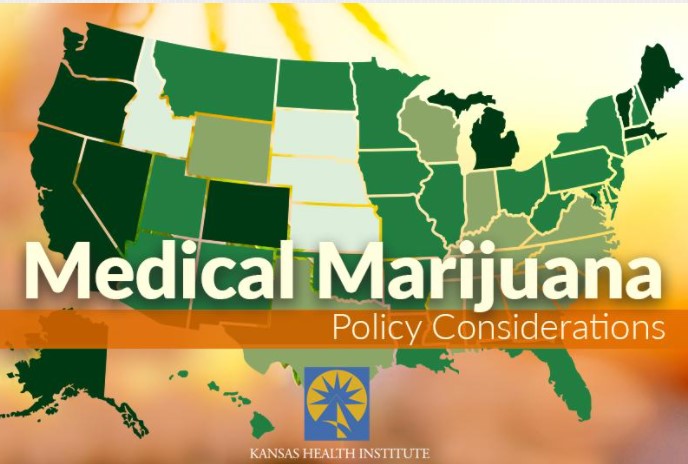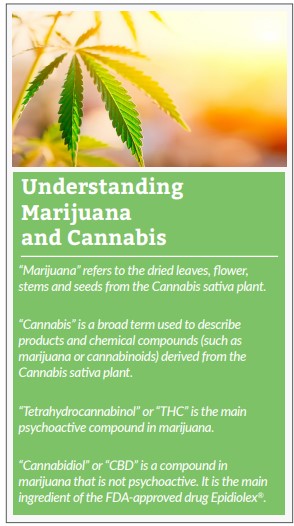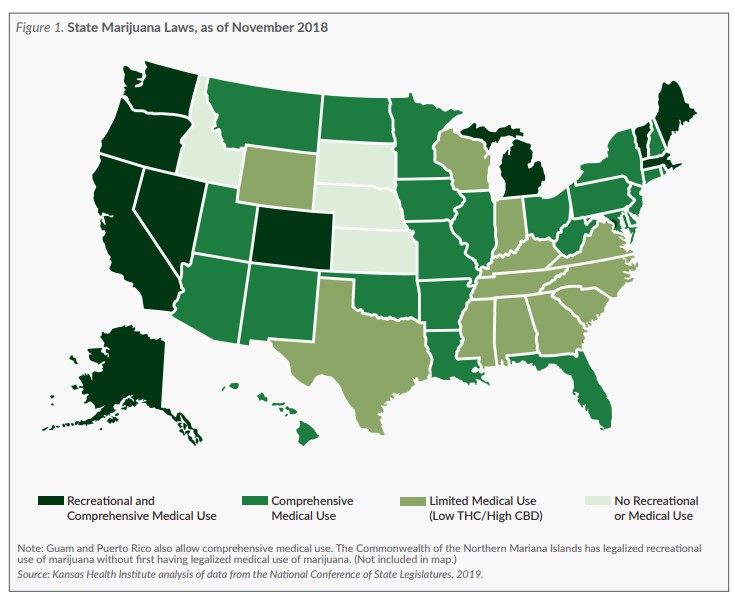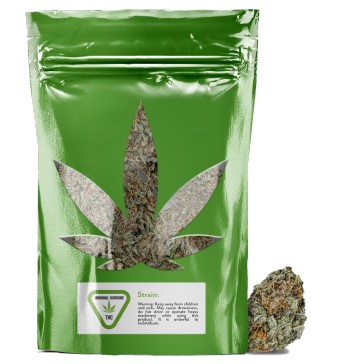Kansas Efforts to Legalize Medical Marijuana
Eighteen bills to establish a medical marijuana program have been introduced in Kansas since 2006. Most of the legislation specified qualifying medical conditions, set taxes and fees, and permitted the establishment of dispensaries. While some of these bills established maximum THC concentration, none established limits on CBD concentration. In 2018, Kansas passed legislation excluding CBD from the state definition of marijuana, thereby permitting the legal, retail sale of CBD products with no limits on qualifying medical conditions, age or other restrictions typical in other states. In November 2018, a web-based search identified 128 individual stores in 45 towns or cities in Kansas selling CBD products. Examples of products include tinctures, oral capsules, lotions and edible products such as gummies, chocolates and cookies. Many of these stores also offer online sales.
Therapeutic Effects and Health Risks of Marijuana Use
In 2017, prior to the FDA approval of Epidiolex®, the National Academies of Sciences, Engineering, and Medicine (the National Academies) published a comprehensive study of the medical and scientific literature regarding the health effects of marijuana. This study reported conclusive or substantial evidence of modest therapeutic benefit for the following:
-
- In adults with chemotherapy-induced nausea and vomiting, oral cannabinoids are effective antiemetics;
- In adults with chronic pain, patients treated with cannabis or cannabinoids are more likely to experience a clinically significant reduction in pain symptoms; and
- In adults with multiple sclerosis (MS)-related spasticity, short-term use of oral cannabinoids improves patient-reported spasticity symptoms.
While the National Academies study found moderate or limited evidence of therapeutic benefit for some other conditions evaluated, firm conclusions could not be made.
The National Academies study also concluded that marijuana use is associated with increased health risks, such as respiratory problems, lower birth weight in the offspring of women who smoke marijuana during pregnancy, problem marijuana use or other substance dependence, psychosocial impairment and mental health problems.
Impact on Driving Under the Influence, Traffic Crashes and Fatalities
The National Academies study and other research have demonstrated that marijuana use impairs driving-related skills and increases the risk of motor vehicle crashes. However, the overall impact on the population is less clear. For example, although the U.S. Department of Transportation, in a 2017 report to Congress, stated that several indicators suggest that a problem exists, the scope and magnitude of marijuana-impaired driving could not be clearly specified.
Furthermore, research examining the impact of marijuana legalization on motor vehicle crashes is limited and findings have been mixed. Some studies have found that marijuana legalization is associated with increased risk of crashes, while others have found that the risk of crashes declines after legalization. Still others found that marijuana legalization has had no impact on crash risks.
It is important to note that this research is challenging because there is no standard to measure marijuana impairment through laboratory testing and no uniformity in defining impairment among law enforcement.
Marijuana-Related Exposures Reported to Poison Control Centers
As additional states have legalized marijuana, concerns about unintentional exposures have increased. Although marijuana and other cannabis products account for a small proportion (less than 1 percent in 2016) of all exposures reported to U.S. poison control centers, exposures among all age groups have increased substantially, from 3,699 in 2006 to 7,497 in 2016. Especially concerning are exposures among children. Many edible marijuana products — such as chocolates, candy or baked goods palatable to young children — might contain high amounts of THC, thereby increasing the risk of acute toxicity. Clinical effects vary substantially, but can be severe, including central nervous system and respiratory problems.
Rates of pediatric marijuana exposures have increased significantly more in states that have legalized medical marijuana than in states that have not. An often-cited national study (Wang et al. 2014) found that rates of marijuana exposures among children less than 9 years of age increased by an average 30.3 percent per year between 2005 and 2011 in states that legalized medical marijuana before 2005. In contrast, rates increased by an average 11.5 percent per year in states that legalized medical marijuana between 2005 and 2011 and an average of 1.5 percent per year in states that did not legalize medical marijuana.
Impact on Opioid Prescribing and Opioid-Related Mortality
While some studies suggest that decreased prescription opioid use and overdose deaths are associated with legalized medical marijuana use, there have been conflicting results. Studies based on self-report surveys among patients generally have shown a strong correlation between medical marijuana use and decreased opiate use, while studies examining the association between opioid prescribing rates and medical or recreational marijuana use laws have shown moderate impacts. The mechanism by which opioid prescriptions are reduced is unclear. Some studies suggest that medical marijuana augments the analgesic effects of opioids, thereby allowing for a lower dose of opioids. Other studies found that states with operational networks of medical marijuana dispensaries may experience a greater decrease in opioid prescribing than states without these networks. While declines in opioid mortality rates have been observed following the passage of medical marijuana legislation, there has not been enough research to establish a causal relationship.



